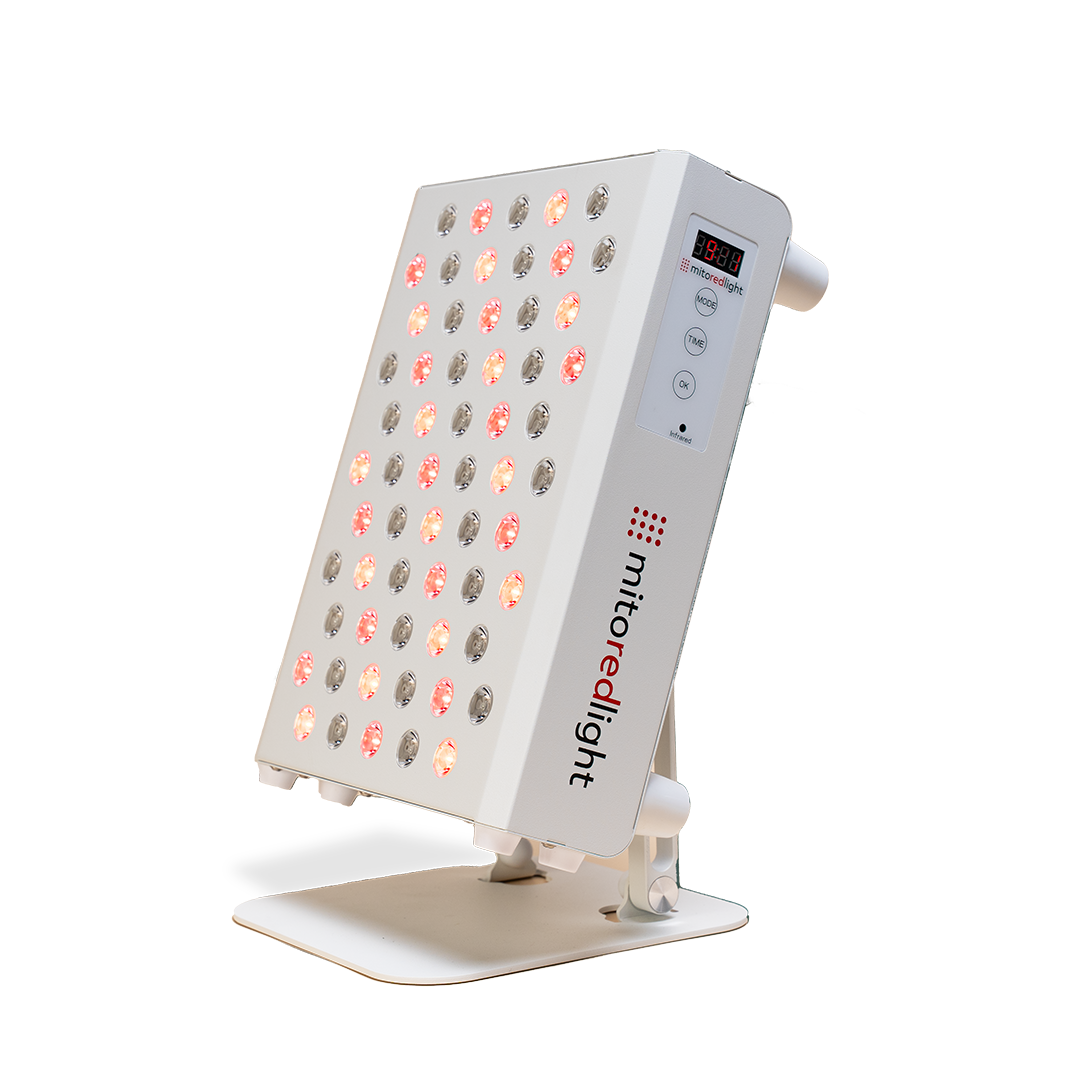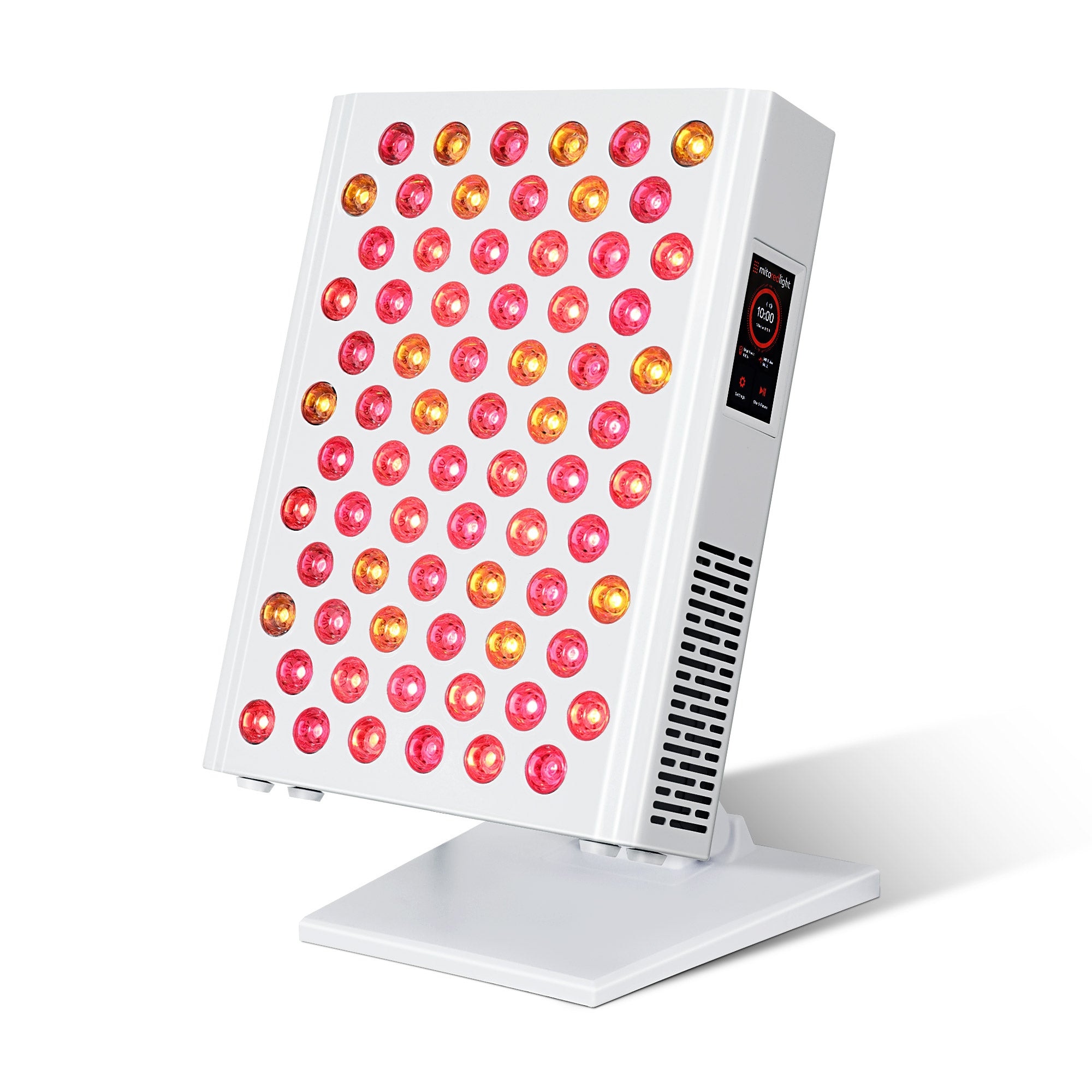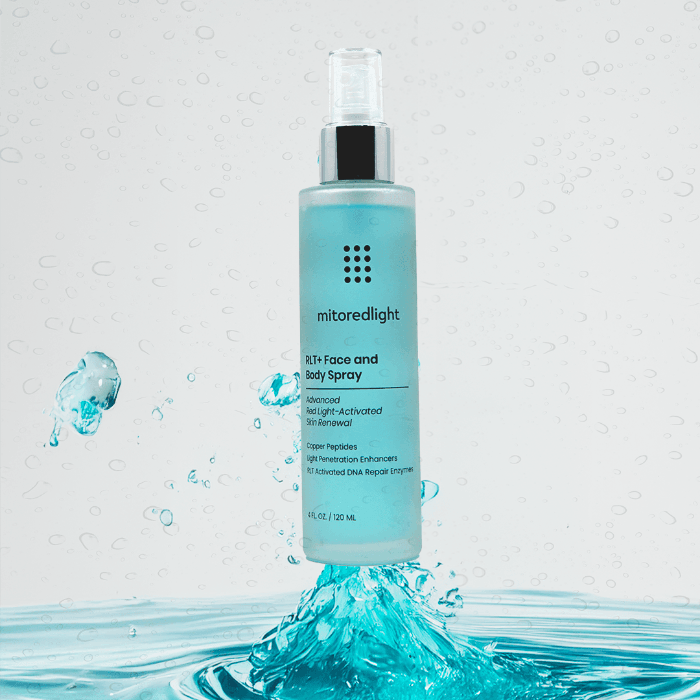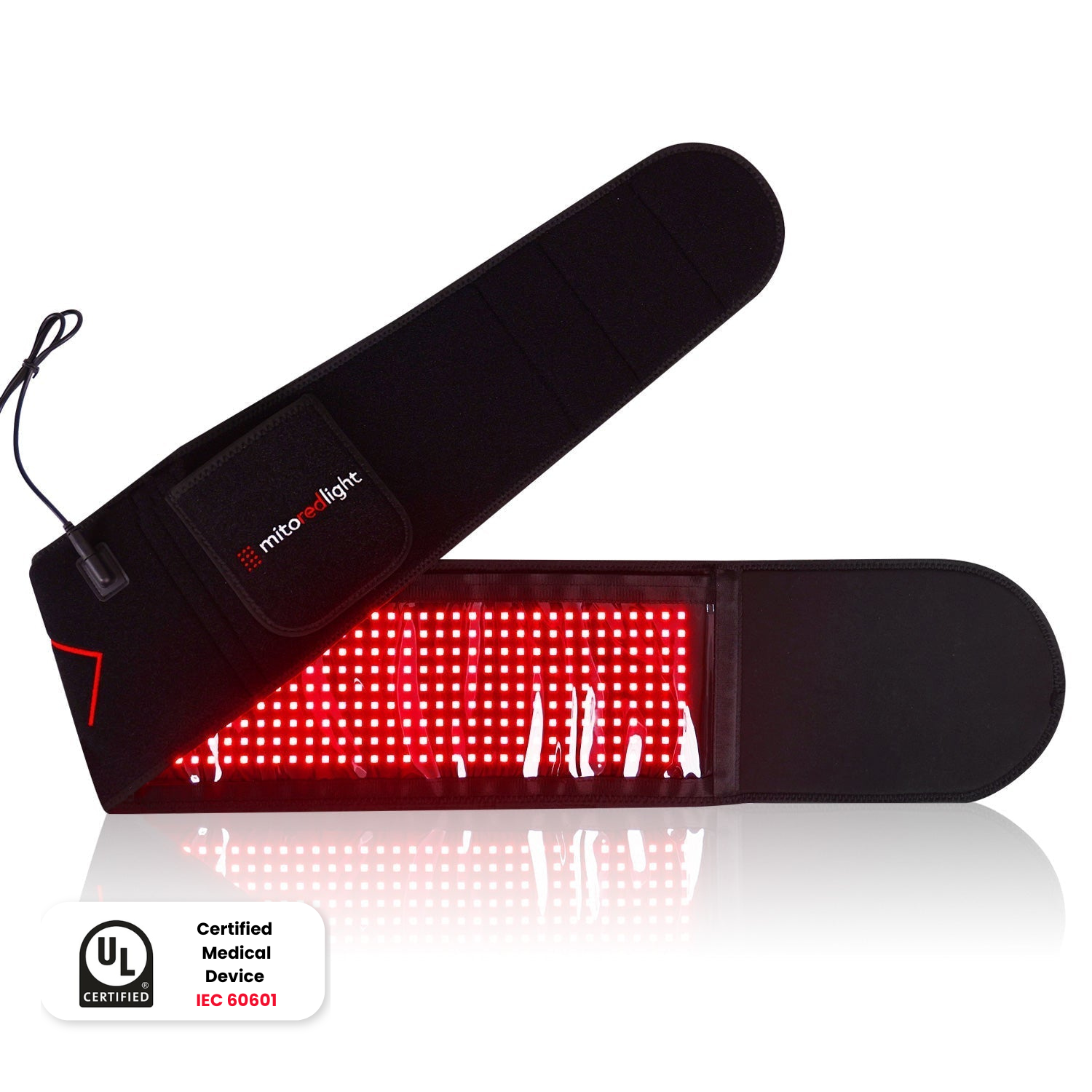DISCLAIMER: Mito Red Light devices are Class II wellness devices aimed at affecting the body through topical heating and supporting cellular function. The information provided in this article and on this site is for educational purposes only and is not intended to imply effectiveness of Mito Red Light devices for any specific application. The information provided in this article and on this site is not intended to diagnose, treat, cure, or prevent any disease, is not a substitute for consultation with a licensed medical provider and should not be construed as medical advice. Click here to read our article on potential contraindications of red light therapy..
Executive Summary
This Mito Red Light article explores the potential of red light therapy (RLT) as a supportive approach for managing psoriasis, a chronic autoimmune skin disease characterized by rapid skin cell turnover and scaly patches. Traditional treatments include topical corticosteroids and salicylic acid, phototherapy (UVB, PUVA, excimer laser), and systemic medications like biologics and methotrexate. RLT, using specific red and near-infrared light wavelengths, works by supporting cellular energy production, potentially aiding collagen production, providing calming effects, and supporting circulation. While not a standalone cure, RLT may offer a non-invasive, soothing option for psoriasis management. General tips for using RLT include consulting a dermatologist, choosing quality devices like MitoPRO X, starting with short, consistent sessions, considering full-body therapy with devices like MitoPOD, being patient, and avoiding sunburns.
Key Takeaways:
- Psoriasis is a chronic autoimmune skin disease with rapid skin cell growth.
- Traditional treatments aim to reduce inflammation and slow cell turnover.
- Red light therapy may support skin health through cellular energy and calming effects.
- Consulting a dermatologist is crucial before using RLT for psoriasis.
- Consistent use of quality RLT devices may offer a supportive role in managing psoriasis symptoms.
Medically Reviewed by | Heidi Wright, BSN, RN, PCCN
At Mito Red Light, we're constantly exploring how the innovative power of red and NIR light therapy can be part of your health and wellness routine. Psoriasis, a persistent skin condition affecting millions, often requires ongoing management. Traditional methods have their place, but what about alternative options?
In this article, we dive deep into whether red light therapy could play a supportive role in managing psoriasis symptoms. By shedding light on the science behind this therapy, we aim to illuminate potential paths toward enhanced skin health, keeping in mind the importance of ongoing research and careful consideration in healthcare choices.
What Is Psoriasis?
Psoriasis is a chronic autoimmune disease that predominantly affects the skin but can have systemic impacts as well.
In psoriasis, the immune system mistakenly attacks healthy skin cells, accelerating their growth cycle. This rapid turnover leads to the buildup of cells on the skin's surface, forming scaly patches.
The most common form, plaque psoriasis, manifests as raised, red patches covered with a silvery buildup of dead skin cells or scales. These patches can be itchy, painful, and are often found on the scalp, elbows, knees, and lower back.
Beyond physical discomfort, psoriasis can profoundly affect a person’s quality of life, leading to emotional distress and, in some cases, social stigma. Psoriasis is also linked with other health conditions, such as psoriatic arthritis, a specific type of arthritis that affects some people who have psoriasis.
Heidi Wright, Registered Nurse, notes that in the context of chronic disease, "chronic" refers to a condition that has several key characteristics:
- Long-lasting: Chronic diseases typically persist for months or years, often throughout a person's lifetime. They are not temporary illnesses that resolve quickly with treatment.
- Persistent: Chronic diseases can have periods of flare-ups where symptoms worsen, but they don't fully disappear. Even during periods of remission (reduced symptoms), the underlying condition is still present.
- Requires ongoing management: Chronic diseases often require ongoing medical attention, medication, or lifestyle changes to manage symptoms and prevent complications. While there may be treatments that can improve a person's quality of life and even achieve remission, there's usually no permanent cure.
- Limits daily activities: Chronic diseases can significantly impact a person's ability to perform daily activities, depending on the severity of the condition. This can include limitations on work, hobbies, and social interactions.
What Are the Traditional Methods Used To Manage Psoriasis?
When it comes to managing psoriasis, a variety of traditional treatments are available. These methods aim to reduce symptoms, slow down the rapid growth of skin cells, and improve overall skin health. Each approach has its own set of benefits and potential side effects.
Topical Treatments
Topical treatments are often the first line of defense in managing psoriasis. These include creams and ointments applied directly to the skin to reduce inflammation and slow cell turnover:
- Corticosteroids: These soothing creams are often recommended for mild to moderate psoriasis. They work to alleviate redness and itching but should be administered with care to avoid potential side effects like skin thinning.
- Salicylic Acid: Often found in over-the-counter treatments, salicylic acid helps remove scales and smooth the skin. It's frequently used in combination with other therapies to enhance effectiveness.
- Calcipotriene: This vitamin D analog slows skin cell growth and can be effective in treating psoriasis plaques. It’s often used alongside corticosteroids for better results.
Phototherapy
Phototherapy involves exposing the skin to specific types of light to help manage psoriasis symptoms. This method is usually conducted under medical supervision.
- UVB Phototherapy: This type of light therapy uses ultraviolet B (UVB) light to slow the growth of affected skin cells. Narrowband UVB is a more targeted form of this treatment and can be more effective.
- PUVA (Psoralen + UVA): This treatment combines UVA light with a drug called psoralen, which makes the skin more sensitive to the light. PUVA can be effective but may increase the risk of skin cancer with prolonged use.
- Excimer Laser: This type of laser therapy uses a focused beam of UVB light to treat small areas of skin, making it suitable for localized psoriasis.
Systemic Treatments
For some cases of psoriasis, systemic treatments are often necessary. These are typically used when topical treatments and phototherapy are not fully effective.
- Biologics: These drugs target specific parts of the immune system. Biologics are often prescribed for moderate to severe psoriasis and psoriatic arthritis. They are administered by injection or infusion and require regular monitoring by a healthcare provider.
- Methotrexate: This oral medication helps reduce inflammation and slow skin cell production. “Methotrexate is a type of disease-modifying anti-rheumatic drug (DMARD). It's used to reduce activity of the immune system for people who have certain conditions, such as psoriasis,” notes Wright.
- Cyclosporine: An immunosuppressant. It is often used to help control inflammation in some autoimmune diseases like severe psoriasis and rheumatoid arthritis.
Alternative and Complementary Therapies
Many people choose to explore alternative treatments to manage their psoriasis, as a complement to their medical treatment plan
- Supplements: Some individuals find relief by taking supplements, though more research is needed to confirm their efficacy.
- Dietary Management: “While there's no one-size-fits-all psoriasis diet, some people find relief by focusing on anti-inflammatory foods like fruits, vegetables, and lean proteins while limiting processed foods, sugary drinks, and unhealthy fats,” notes Wright. This dietary approach may help manage flare-ups and improve overall well-being.
- Stress Management: Techniques like mindfulness and yoga can help manage the stress that can trigger some psoriasis flare-ups.
How Does Red Light Therapy Work?
Red light therapy, also known as low-level light therapy (LLLT), harnesses specific wavelengths of light to support the body’s natural processes. Unlike ultraviolet (UV) light, which can harm skin cells, red and near-infrared (NIR) light is non-ionizing and penetrates the skin without causing damage.
In today’s world, most of us are spending more and more time indoors — which can cause us to lack exposure to certain wavelengths found in natural light. Red light therapy can help make up for this, thus supporting overall wellness.
Here’s how it works:
Cellular Energy Support
Red light therapy targets the mitochondria, the powerhouses of cells. The light photons are absorbed by mitochondrial chromophores, increasing the production of adenosine triphosphate (ATP), the cell's energy currency. Enhanced ATP production supports cellular function, aiding in skin repair and regeneration.
Potential Support for Collagen Production
Collagen is vital for maintaining skin structure and elasticity. Red light therapy may help support healthy collagen production, supporting skin texture, reducing the appearance of fine lines, and supporting overall skin health.
Calming Effects
Red light therapy has a soothing effect on the skin, working to soothe irritation and support overall comfort.
Circulation Support
Red light therapy supports overall circulation, maintaining the proper delivery of oxygen and nutrients to the skin. Better circulation promotes healing and overall skin health.
What Are Some General Tips for Using Red Light Therapy?
If you're considering red light therapy to support your overall skin health, here are some tips to help you maximize its benefits effectively and safely:
Consult with a Dermatologist
Before starting any new therapy, it's crucial to consult with a healthcare provider, especially a dermatologist who specializes in skin conditions. They can provide personalized advice and ensure that red light therapy is suitable for your specific case.
Choose High-Quality Devices
Using high-quality devices is essential to ensure you get the appropriate wavelengths and intensity for effective results.
At Mito Red Light, our products are designed with advanced technology to provide optimal red and NIR light therapy. Our MitoPRO X Series offers a user-centric design, touchscreen interface, and multiple wavelengths for comprehensive red light therapy sessions.
Start With Short Sessions
Begin with shorter therapy sessions and gradually increase the duration as your skin adapts. This approach helps minimize any potential side effects and allows your skin to get used to the new therapy.
Maintain Consistency
Consistency is key to seeing results with red light therapy. Aim for regular sessions, as prescribed by your dermatologist, to support the health and function of your skin cells effectively.
Focus on Full-Body Techniques
For comprehensive benefits, consider full-body red light therapy sessions. Our MitoPOD™ offers an unparalleled solution for full-body red light therapy at home or on the go. With its exclusive triple-chip diode design, it ensures a comprehensive red light session.
Be Patient
Red light therapy is not an overnight solution. It may take several weeks to see noticeable improvements in your skin. Patience and consistency will yield the best results over time.
Avoid Sunburns and Tanning
While red light therapy is beneficial, exposure to UV light from tanning beds or excessive sun can exacerbate psoriasis symptoms. Red light therapy provides a safe alternative without the risks associated with UV exposure.
The Bottom Line
So, does red light therapy help with skin health? The evidence so far suggests it holds promise as a supportive approach. While more research is needed to fully understand its efficacy, red light therapy offers a non-invasive, soothing option that can be integrated into a comprehensive skincare routine.
At Mito Red Light, we are committed to providing advanced, high-quality devices to help you explore the potential benefits of red and NIR light therapy. Ready to enhance your wellness? Discover our range of innovative red light therapy products and see how Mito Red Light can be part of your journey.
Click to learn more about potential red light therapy benefits.
Find Commercial Mito Red Light Therapy Near Me
To learn more basics, read How Does Red Light Therapy Work?
Check out our reviews for Red Light Therapy Before and After
Related Articles:
Infrared Sauna vs. Red Light Therapy
Red Light Therapy Masks vs. Panels
Red Light Therapy for Eczema: How It Might Help
Does Red Light Therapy Help Rosacea?
Sources:
What Are the Related Medical Conditions of Psoriasis? | National Psoriasis Foundation
Red Light Therapy: Benefits, Side Effects & Uses | Cleveland Clinic
Psoriasis clinical guideline | American Academy of Dermatology Association
Psoriasis treatment: Biologics | AAD























